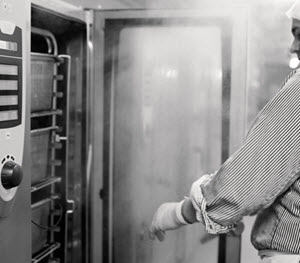Cold Food Storage Tips
Posted on 19th Dec 2017

Food safety is at the top of every restaurateurs mind. One of the first places to start to ensure the food served to guests meets all health and safety standards is the fridge—or more specifically the refrigerator and the freezer. Far too many people believe that once a food item has been packed away and stored in the freezer, it’s safe to use days or even weeks later. That may not always be the case.
Because of this, DayMark Safety Systems offers the following fridge and freezer cold food storage tips:
Cleanliness. Although freezing temperatures can prevent the growth of some bacteria, it does not necessarily kill it—it essentially allows the bacteria to hibernate. We don’t want any of this sleeping bacteria coming in contact with food items, and the best way to prevent this is to keep freezers and refrigerators clean at all times. An all-purpose cleaner followed by using a sanitizer or disinfectant may be necessary to ensure the insides of refrigerators and freezers are clean and bacteria free.
Use By. Every food item delivered to a restaurant should be labeled with a “use by” date. If the item is placed in a container, the label should be placed on the container. This way kitchen staff know when a food item should be used and when it may need to be tossed away.
FIFO. When storing food in the freezer or refrigerator, always abide by the FIFO rule: first in, first out. Stock rotation(e.g. selecting items that are stored in the back of the freezer/refrigerator first) helps prevent food spoilage. While it may be tempting—and certainly a lot quicker and easier—to select food items in the front of the freezer, this can result not only in food spoilage but food waste, which is like money tossed in the trashcan.
Store Low. Many food service professionals are unaware of the fact that meat should always be stored at the bottom of the freezer and refrigerator. The concern is not so much that this might be the coldest area in the freezer/fridge, but this practice helps prevent meat juices from dripping onto other food items, potentially contaminating them.
Overstocking. A crowded fridge can impact temperature settings. Too many food items placed in the freezer/refrigerator, especially at the same time, can cause temperatures to rise. This can result in food spoilage, which, in turn, can cause food poisoning to occur. To help prevent this, remove any out-of-date food items from the refrigerator or have more than one freezer/refrigerator to avoid overstocking.
Temperature Monitoring. Restaurateurs must be aware of the legalities when it comes to storing food at the proper temperature. While this may vary in different communities, typically the refrigerator must be kept at or below 40 degrees (F), while the freezer is kept at or below 0 degrees (F). However, these temperatures can vary if, for instance, the refrigerator is overstocked, too many “warm” items have been placed in the unit, or a power failure occurs.
To ensure food is stored at the right temperature, DayMark Safety Systems has partnered with Hawk Safety to offer a paperless technology with temperature monitoring sensors that record and store food temperature inside freezers and refrigerators. The system also delivers real-time alerts to kitchen staff should these temperatures vary beyond a critical point.
The system helps ensure food safety, giving restaurateurs one less thing to be concerned about.
More about the features and benefits of the Hawk Safety system can be found here or contact a DayMark representative at 866-517-0490.


